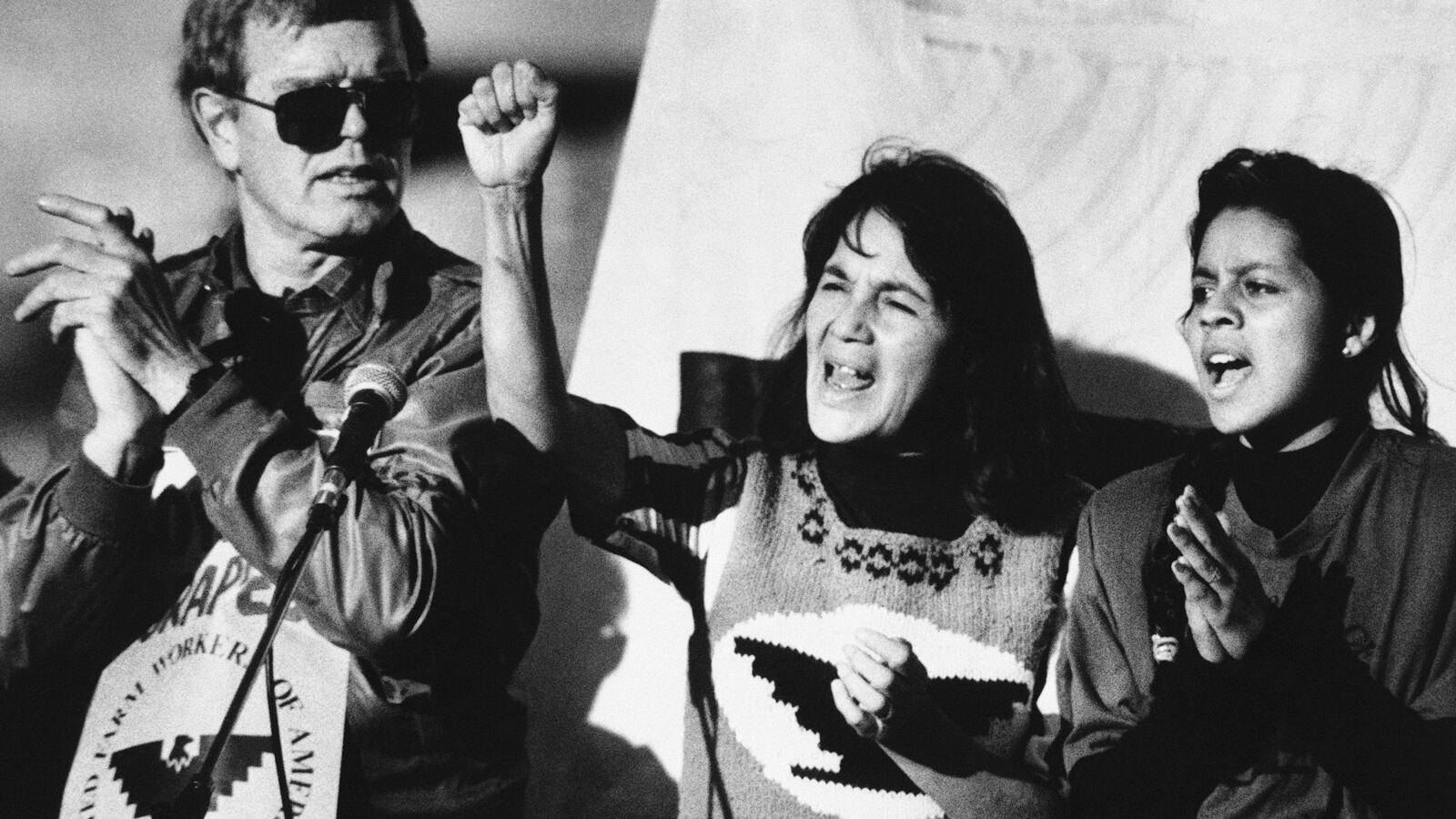About halfway through Dolores, a new documentary about civil rights icon Dolores Huerta, the film cuts to archival footage of Robert F. Kennedy’s acceptance speech at the Ambassador Hotel in Los Angeles following his victories in the California and South Dakota primaries. As a viewer, you know what comes next. You know that the assassin’s bullet is moments away, and that the dream of continuing Camelot and the Great Society will soon be dashed. Yet as you watch Kennedy give his speech, you can’t look away from the Latina woman with an ear-to-ear smile in a red dress, and with a red United Farm Workers of America (UFW) flag in her hair.
Huerta, the co-founder of the UFW and creator of the organization’s slogan Si se puede, which President Barack Obama adopted and translated into “Yes We Can” in the 2008 election, stood next to RFK on that fateful night. For those outside the Latino civil rights, environmental justice, or California labor movements, Huerta’s name may be unfamiliar, but she has been one of America’s most impactful civil rights leaders over the past 50 years.
The film describes Kennedy’s assassination as feeling like the “death of the future,” but Huerta’s commitments remained undeterred despite the tragic event of June 6, 1968. She was already a trailblazer and visionary before tragedy struck, and Dolores takes you on an emotional journey through the ups and downs, both political and personal, of a life devoted to civil rights. You see Huerta grow from a young girl who loved dancing and jazz to a leader of a movement.
In 1962 Huerta and Cesar Chavez founded the UFW to combat the abhorrent labor conditions that farm workers faced in California. Agriculture workers had been left out of all the New Deal-era labor advances because of the political muscle of agribusiness. Into the 1960s, farm workers, who were mostly Latino and Asian, lived lives of modern-day slavery. The sexual assault of women was extremely common. Workers were paid next to nothing, worked in contaminated fields due to the widespread use of pesticides, and many lived in houses owned by the owner of the farm.
These workers were left defenseless against their abusive employers, and challenging authority to combat rampant abuse could result in both a loss of employment and one’s home. The film includes interviews from farm workers describing how their skin itched and burned as they were repeatedly doused with pesticides, and shows images of children born with missing limbs. In each interview, you could feel how powerless the farm workers felt, and how the UFW made them realize that they could improve their lives.
The UFW changed the dynamic between farm workers and employers. Chavez and Huerta implemented a campaign to mobilize workers to challenge agribusiness and negotiate for better working conditions. Via organized strikes and protests, the UFW got paid vacation, health plans for workers and more. They also created savings accounts and financial support systems for the workers. The union had a strong first few years.
However, the 1965 strike by Filipino grape pickers in Delano, California changed Chavez and Huerta’s plans. Up to this point, the Filipino workers hadn’t been much on their radar, but Huerta and Chavez refocused their efforts to support them and unite them with their coalition of Latino workers. The UFW also practiced the principles of nonviolence espoused by King and Gandhi. Huerta and Chavez’s movement now included black, Latino and Asian voices. And as their national profile grew, religious leaders, feminists and prominent Democratic politicians also supported their cause. Angela Davis and Gloria Steinem were and still are major allies of Huerta.
Kennedy also became a vocal supporter of the UFW around this time, and Dolores includes some great footage of Kennedy telling a law enforcement official in Delano, California to re-read the Constitution to learn that he cannot arrest Latinos unless a crime had been committed. The official had been systematically arresting Latinos in order to stop the labor protests.
To support the grape pickers, the UFW organized a nationwide grape boycott, and in 1966, they marched from the grape fields of Delano, California to the capitol in Sacramento. At each protest, they were met by a militarized police force that assaulted protestors with clubs, teargas, and violated their civil rights. The footage of police brutality parallels with images from Montgomery and Selma, and the image of a Latino man being choked by police in the grape fields of California immediately made me think about Eric Garner.
The march to Sacramento and the grape boycott helped propel the UFW to a national audience, but it also furthered the resolve of California’s government to defeat the movement. Ronald Reagan, California’s new governor, had the state buy large quantities of grapes to offset the losses from the boycott, and was regularly seen eating grapes. In one scene, Reagan is shown eating from a bushel of grapes at a fancy dinner.
Eventually, UFW won and made new labor contracts with California’s grape producers to benefit workers.
Despite her accomplishments, Huerta in the eyes of many was viewed as Chavez’s influential assistant and not his equal. Many people thought Chavez founded, not co-founded, the UFW and attributed their slogan Si se puede to him. The documentary astutely traverses the gender dynamics of their relationship and her public perception by frequently cutting to a televised interview featuring both of them. Chavez’s questions pertain to leading the organization or protecting Huerta, and her questions focus on motherhood, and asking if she ever wants to take a day off and go to a spa.
Additionally, interviews with Huerta’s children — she raised 11 of them as she built a movement — feature prominently in the film. They discuss the hardships they endured as their mother was away for long stretches of time, and how as children they did not fully understand the significance of her work. As adults, they understand why she did what she did. Now many of them work as civil rights activists and lawyers.
Today, 87 and still active, her life’s work shows how environmentalism, civil rights, feminism, labor movements, and combating racial oppression all intersect. In the film, Steinem speaks at length about how Huerta influenced her, and Davis even describes Huerta’s life as “lived intersectionality.” She still loves to dance too, but as the film says, “she loves people more than dancing,” and has chosen a life devoted to civil rights.
In 2012, when she was 82, President Barack Obama awarded Huerta the Presidential Medal of Freedom, and in his speech, he acknowledged that Huerta was the originator of his famous phrase, and was thankful that she let him borrow it. Huerta has changed the lives of countless Americans for the better, and many of us have never even heard her name or known her story. Dolores allows us to correct this mistake and acknowledge the considerable impact this woman has had on all of our lives.






